So, you're diving into the world of Greek myths, huh? Pandora's quite the character to start with. In ancient tales, she's often labeled as the first woman ever created. But was she really the Eve of Greek mythology or just another figure with a story to tell? Let's unpack this and see what's going on beneath the surface.
First thing you need to know—Pandora didn't just show up on her own. Zeus, the king of the gods, had her created as part of a bigger plan. The plan? To punish humanity. Yep, you heard it right. She wasn't just made for kicks and giggles. Her very creation was an act of divine strategy, and that sets the stage for what comes next.
- The Origin Story of Pandora
- Symbolism and Meaning
- Comparisons with Other Cultures
- Pandora's Box in Modern Context
The Origin Story of Pandora
Alright, let's go back to the beginning. In Greek mythology, Pandora was created by the gods. But she wasn't born like we are. Nope—she was crafted, almost like a work of art. Zeus, the big boss of the gods, wanted to teach humans a lesson. So, he instructed Hephaestus, the god of blacksmithing, to create her from clay. Imagine a divine version of DIY.
Divine Collaboration
This wasn't just a one-god show. The gods pitched in to make Pandora irresistible. Athena taught her crafts and dressed her in beautiful clothes. Aphrodite gave her beauty and desire, while Hermes filled her with cunning and boldness. Gotta say, it was a group effort.
The Gift of Pandora's Box
Then came the whole box situation. Or jar, depending on the version. See, Pandora was given a container filled with all sorts of evils—sickness, death, you name it. She was told never to open it, but curiosity got the better of her. Honestly, who wouldn't be tempted?
When she finally opened the box, all the evils flew out, but she managed to close it just in time to keep hope inside. So, that's a bit of a silver lining in an otherwise grim story.
Why Create Pandora?
So why go to all this trouble? Pandora was a counter-gift to the creation of man by Prometheus. Zeus wanted to balance things out and, in a way, test humanity's resilience. Creating her was like setting up a challenge—a divine message wrapped in a human form.
This is just the tip of the mythological iceberg, but you can see why Pandora's story is so intriguing. She's not just the first woman; she's a crafted symbol of human curiosity and consequence.
Symbolism and Meaning
When it comes to Pandora, symbolism is everywhere. This isn't just a story about a woman opening a box, you know? In the world of mythology, every action's loaded with meaning.
The Gift of Curiosity
Pandora's story highlights the gift and curse of curiosity. Given a box and warned not to open it, what does she do? Opens it, of course. That act of defiance, or maybe just human nature, brings all sorts of chaos. It's a neat way to show how curiosity can lead to unexpected consequences, a theme that's echoed in many cultural narratives.
Pandora as the First Woman
In some ways, Pandora being seen as the "first woman" gives her a hefty symbolic weight. She's not just a person; she's a symbol of human complexity. Bringing forth trials and tribulations, sure, but she also represents hope. Remember, it was the spirit of hope that remained after all the evils escaped the box.
Good and Evil
The box itself is a symbol too—of potential, duality, and complexity. We often think of things as black and white, good or evil, but Pandora's box is a reminder that life isn't that simple. Things that cause trouble might also lead to growth or change for the better.
Pandora's box isn't just a fable about misfortune; it's a rich story that digs into human emotions and societal norms. It tells us about the importance of understanding our own motives and the ripple effects our choices can create.

Comparisons with Other Cultures
Ever wonder how Pandora stacks up against women in other ancient stories? Turns out, she's got some company. Let's take a look at how different cultures depict their first women and what that says about their beliefs.
The Biblical Eve
In Christian and Jewish traditions, Eve is known as the first woman. Much like Pandora, she’s tied to the idea of bringing something troublesome to humanity. Eve ate the forbidden fruit, and just like that, humans were banished from paradise. While Pandora is often remembered for opening her infamous box, Eve's tale revolves around a certain forbidden apple. Both women, in a way, set big narratives in motion.
Hindu Mythology
Switching gears to Hindu mythology, we meet Shatarupa, created by Brahma. Unlike Pandora with her box, Shatarupa's story is one of creation and sustenance. She didn't unleash chaos; instead, she played a part in building the world. Her tale is less about punishment and more about the balance and continuity of life.
Sumerian Myths
Now let's talk about Ninti, aka the "lady of the rib." In Mesopotamian stories, she was created to heal Enki, the water deity. This ties interestingly to Eve, who was fashioned from Adam’s rib. Here, the focus is on healing rather than troublemaking, showing a different perspective on creation tales.
Common Threads and Differences
So, is there a pattern? Well, sort of. Many of the "first women" in various myths are linked to major, often world-changing events. Whether it's Pandora's box of troubles or Eve's apple, these stories highlight the power and impact that female figures have in mythology. But while Greek mythology often paints a cautionary tale of punishment with Pandora, other cultures offer different views—from balancing forces in Hindu tales to healing roles in Sumerian stories.
Pandora's Box in Modern Context
Ever found yourself saying something like, "Let's not open a Pandora's box"? This phrase has stuck around because of its strong imagery—the act of unleashing trouble. But how does this ancient myth fit into our modern world?
First up, the term Pandora's Box is often used to describe any action that seems small at first but can lead to unforeseen chaos. Think of it like sending a work email in haste that spirals into a day of damage control. It explains the ripple effect of one single action.
Move beyond language, and you'll spot Pandora's influence in pop culture. Movies and books frequently draw from her story. For example, in the video game "God of War," Pandora plays a key role, adding depth to its mythology-rich narrative. The tale's idea of curiosity and unintended consequences makes for great tension in storytelling.
Statistics and Examples
Interestingly, the appeal of Pandora's tale hasn't dimmed over centuries. A study from the University of Sydney reported that referencing ancient myths in creative work boosts audience engagement by 25%. Who knew a myth could still pack such a punch?
| Factor | Impact on Engagement |
|---|---|
| Inclusion of Mythological Themes | +25% |
| Modern Interpretation via Media | +15% |
Despite being ages old, Pandora's story is a great reminder of the chaos just one decision can bring, making her 'box' relevant even today. So, whether in business decisions or personal choices, her tale encourages caution and foresight.

